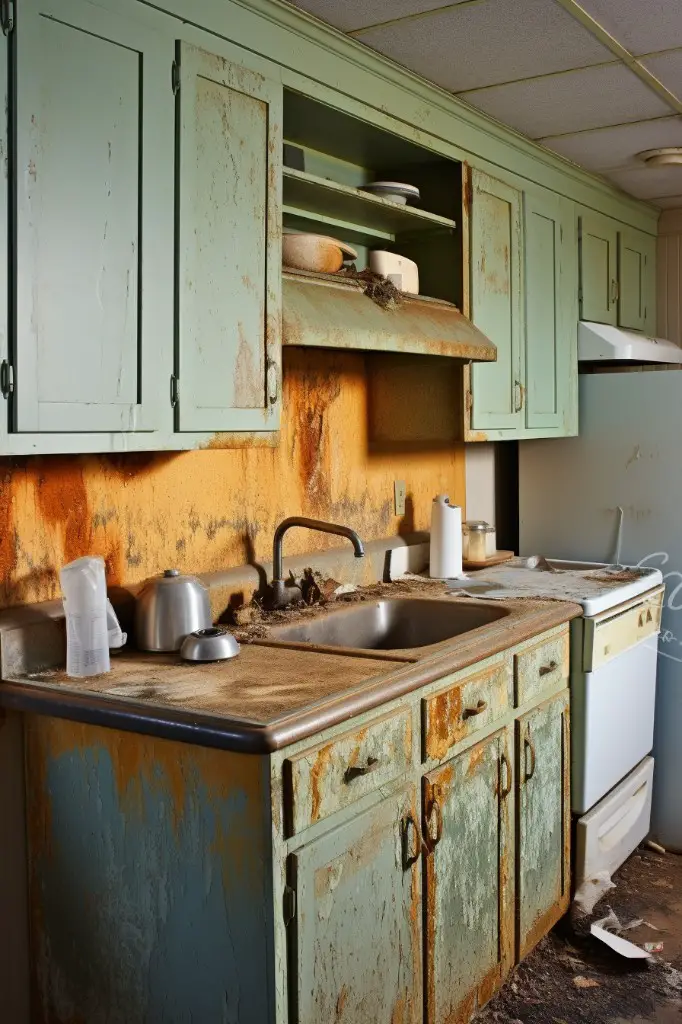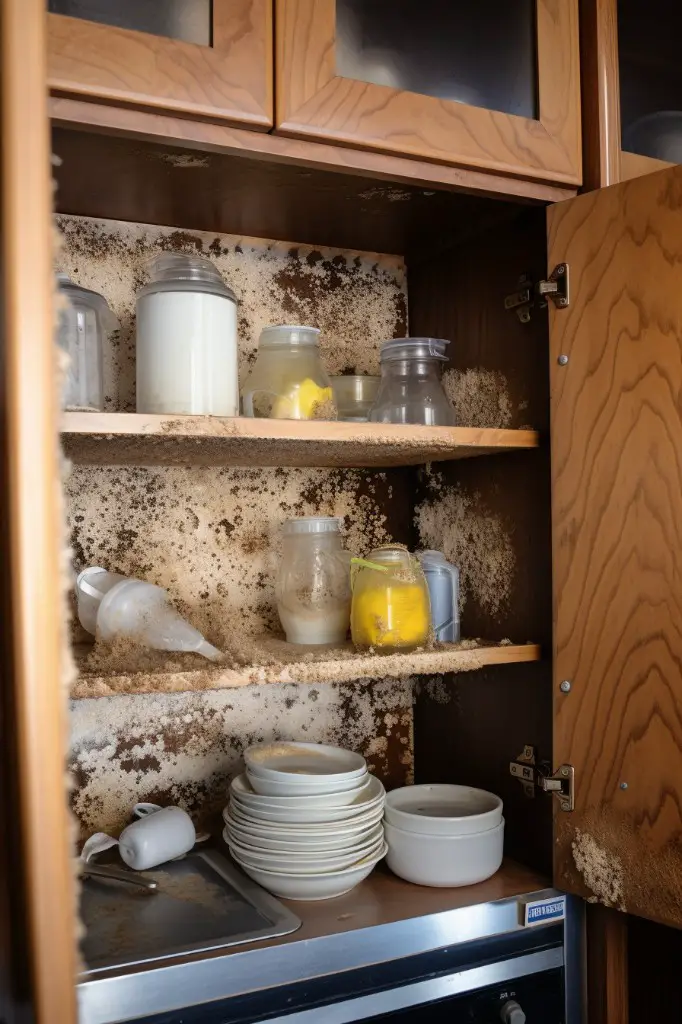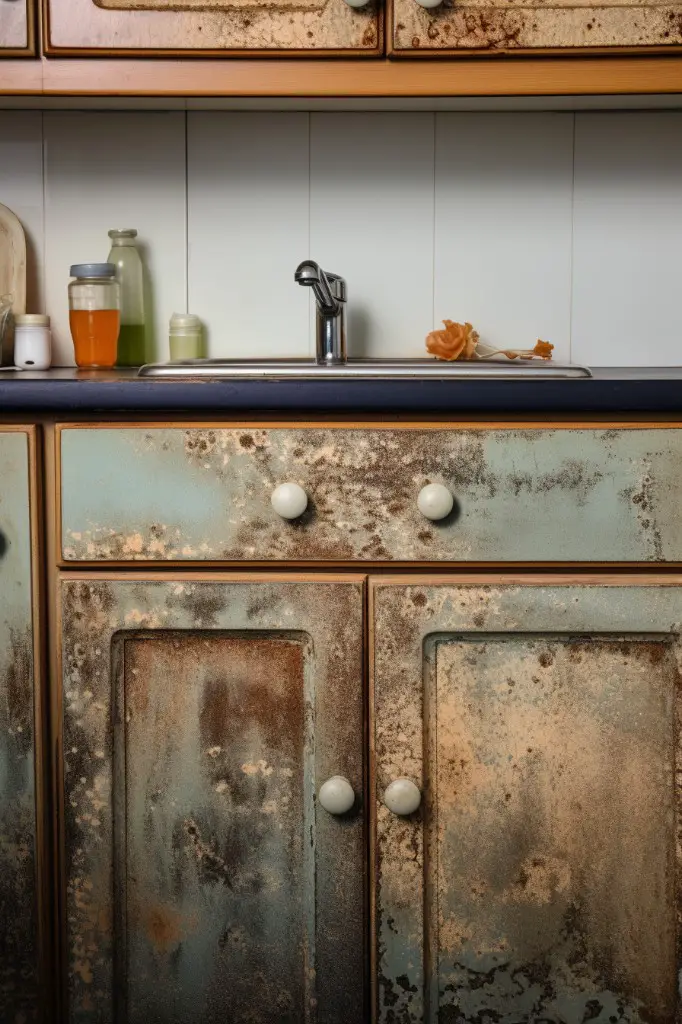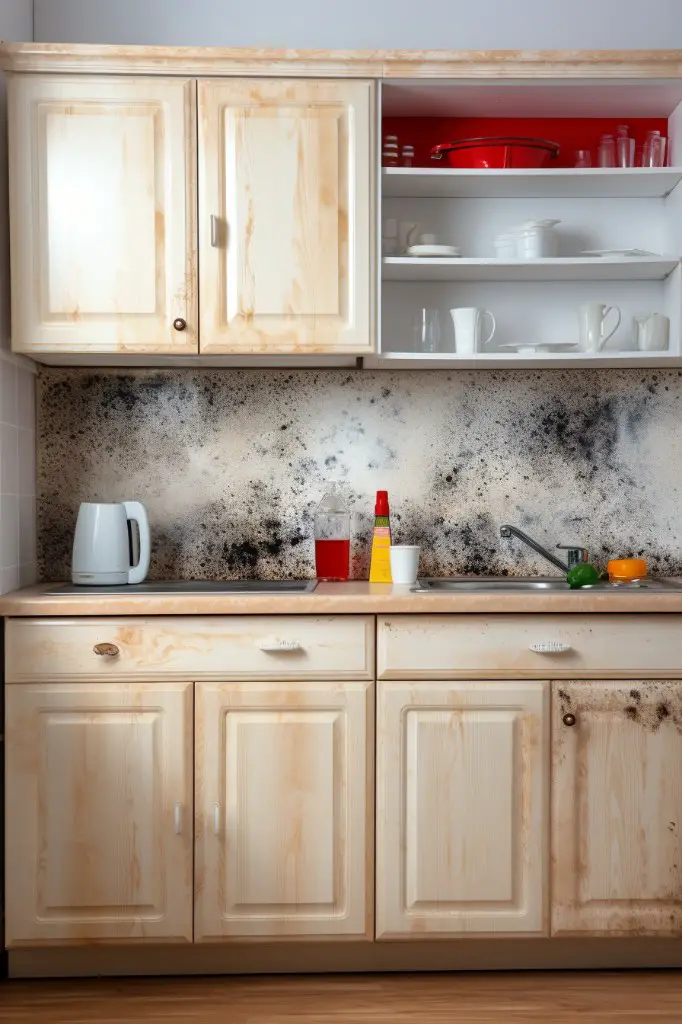Last updated on
Discover the common reasons behind mold growth in your kitchen cabinets and learn how to effectively tackle this persistent problem.
Have you ever opened your kitchen cabinets and been hit with a musty odor? Or perhaps you’ve noticed unsightly black spots growing on the inside of your cabinets. If so, you may be dealing with a mold problem.
Mold growth in kitchen cabinets is not only unsightly but can also be harmful to your health. In this article, we will explore the reasons why mold grows in kitchen cabinets and what steps you can take to prevent it from happening again.
So if you’re ready to say goodbye to that musty smell and hello to a healthier home, keep reading!
What's Inside
Causes of Mold in Kitchen Cabinets

One of the most common causes of mold growth in kitchen cabinets is moisture. Kitchens are often humid environments, and when combined with poor ventilation, it creates an ideal breeding ground for mold.
Leaky pipes or faucets can also contribute to excess moisture in your cabinets.
Another cause of mold growth is food residue left behind on dishes or spills that aren’t cleaned up promptly. Mold spores thrive on organic matter like food particles and can quickly spread throughout your cabinets if not addressed.
Inadequate insulation around pipes running through the cabinet walls can lead to condensation buildup inside the cabinet space which promotes mold growth.
Ideal Conditions for Mold

Unfortunately, these conditions are often present in kitchens and can lead to mold growth inside cabinets. The ideal temperature for mold growth is between 77°F and 86°F (25°C to 30°C), which is why it’s common to find mold growing in areas like the tropics or during hot summer months.
Humidity levels also play a significant role in creating an environment conducive to mold growth. Mold needs moisture to grow, so if your kitchen has high humidity levels above 60%, you may be at risk of developing a problem with cabinet mold.
Poor ventilation exacerbates the issue by trapping moisture inside cabinets and preventing air circulation that could help dry out any dampness before it leads to fungal overgrowth.
Types of Kitchen Mold

In the kitchen, mold can grow on various surfaces such as walls, ceilings, floors, appliances and even inside cabinets. There are several types of mold that can be found in kitchens:
1. Aspergillus: This type of mold is commonly found on food items such as bread or fruits but it can also grow on walls or other surfaces.
2. Cladosporium: This type of mold appears black or greenish-black and often grows in areas with high humidity levels.
3. Penicillium: This blue-green colored mold is commonly found growing on food items like cheese but it can also appear inside cabinets where there’s moisture present.
4. Stachybotrys chartarum (black mold): Black molds are known for their toxic properties which make them dangerous to human health when exposed to them over long periods.
Categories of Household Mold

Allergenic molds are the most common type of household mold and typically cause allergic reactions such as sneezing, runny nose, itchy eyes or skin rashes. Pathogenic molds can cause infections in people with weakened immune systems while toxigenic molds produce mycotoxins that can lead to serious health problems.
Mold growth in kitchen cabinets is a common problem that homeowners face due to the ideal conditions for mold growth – moisture and warmth. Mold spores thrive on organic materials like wood or paper products found inside cabinets which makes them an easy target for infestation.
If you suspect there is mold growing inside your kitchen cabinets, it’s important to identify what type of mold you’re dealing with so that appropriate measures can be taken to remove it safely.
Detecting Mold in Cabinets
There are some signs that you can look out for to detect mold growth in your kitchen cabinets. One of the most obvious signs is a musty odor emanating from the cabinet or surrounding area.
If you notice this smell, it’s likely that mold is growing somewhere nearby.
Another way to detect mold growth is by visually inspecting your cabinets regularly. Check for any discoloration or black spots on the inside of your cabinets as these are common indicators of mold growth.
It’s important to note that not all types of molds appear black; they may also be green, white, yellowish-brown or grayish-white depending on their species and age.
Signs of Mold Growth
There are some telltale signs that you should look out for. One of the most obvious signs is a musty odor emanating from your cabinets.
If you notice this smell when opening your cabinet doors or drawers, it could be an indication that mold is growing inside.
Another sign of mold growth is discoloration on the surface of your cabinets or walls surrounding them. This discoloration may appear as black spots or patches and can spread quickly if left untreated.
If you suspect that there might be mold growing in your kitchen cabinets but cannot see any visible signs yet, keep an eye out for any unexplained health issues such as respiratory problems and allergies which could indicate exposure to toxic spores.
It’s important to note that not all types of molds are visible; some grow within porous materials like wood without showing any external evidence until they have already caused significant damage.
Health Risks of Mold Exposure
When mold spores are released into the air, they can be inhaled and cause respiratory problems such as coughing, wheezing, and shortness of breath. People with allergies or asthma may experience more severe symptoms when exposed to mold.
In addition to respiratory issues, exposure to certain types of mold can also lead to skin irritation or rashes. Prolonged exposure may even result in neurological symptoms such as headaches or memory loss.
It’s important not only for your home but also for your health that you take steps towards preventing the growth of mold in kitchen cabinets. If you suspect that there is already an infestation present within your home, it’s crucial that you address it immediately by following proper safety precautions while cleaning up the affected area.
Identifying Mold and Mildew
While both can grow in damp environments, mold is typically black or green in color with a fuzzy texture. On the other hand, mildew is usually white or gray with a powdery appearance.
To identify mold growth in your kitchen cabinets, look for any discoloration on surfaces such as walls or shelves. You may also notice a musty odor emanating from your cabinets if there’s an infestation of mold.
If you’re unsure whether what you’re seeing is indeed mold growth, it’s best to call in professionals who can conduct tests to determine the type of fungus present. This will help them recommend appropriate remediation measures that will effectively eliminate all traces of harmful spores from your home.
Handling Moldy Food Items
One of the first things you should do is check any food items stored in the affected area. Mold can easily spread from contaminated surfaces to food, and consuming moldy foods can lead to health problems such as respiratory issues or allergic reactions.
When handling moldy food items, it’s crucial that you wear gloves and a mask to avoid inhaling spores or coming into direct contact with them. Discard any perishable foods that have come into contact with the mold immediately – this includes bread, fruits and vegetables, dairy products like cheese or yogurt.
Non-perishable goods like canned goods may be salvaged if they are still sealed tightly without signs of bulging or rusting on their lids. However, make sure that there is no visible sign of contamination inside before using them again.
Dealing With Mold Under the Sink
The area beneath your kitchen sink provides an ideal environment for mold to thrive, with its dark and damp conditions. If left untreated, this can lead to structural damage and pose health risks to you and your family.
To deal with mold under the sink, start by removing all items stored there. This includes cleaning supplies, dishwashing detergent bottles or any other item that may be contributing to moisture buildup.
Next, inspect the pipes for leaks or signs of water damage. Fixing any plumbing issues will help prevent future mold growth.
Once you have addressed any underlying problems causing moisture buildup under the sink, it’s time to clean up existing mold using a solution of bleach and water (1 cup bleach per gallon of water). Wear gloves and protective eyewear while cleaning as bleach can be harmful if it comes into contact with skin or eyes.
Scrub all surfaces thoroughly using a stiff-bristled brush before rinsing them off with clean water. Allow everything dry completely before returning items back into storage underneath your kitchen cabinet.
What to Do Upon Discovering Mold
Ignoring the problem can lead to further growth and potential health risks. The first step is to identify the source of moisture that is causing the mold growth.
This could be a leaky pipe or faucet, poor ventilation, or high humidity levels.
Once you have identified and fixed the source of moisture, it’s time to remove any visible mold from your cabinets. Wear protective gear such as gloves and a mask before starting this process as exposure to mold spores can cause respiratory issues.
To clean up small areas of surface-level mold growth on non-porous surfaces like metal or plastic cabinet doors use soap water solution with bleach (1 cup bleach per 1 gallon water). For porous materials like wood cabinetry use hydrogen peroxide instead (3% concentration).
Steps to Remove Mold From Wood Cabinets
Not only is mold unsightly and can cause a musty odor, but it can also be harmful to your health. Here are the steps you should follow to remove mold from wood cabinets:
1. Wear protective gear: Before starting the cleaning process, make sure you’re wearing gloves, goggles and a mask.
2. Remove items from cabinet: Take out all items stored in the affected cabinet.
3. Vacuum or dust off loose spores: Use a vacuum cleaner with HEPA filter or wipe down surfaces with damp cloth.
4. Mix cleaning solution: Combine one part water and one part vinegar in spray bottle for an effective natural solution; alternatively use commercial cleaners specifically designed for removing mold stains on wooden surfaces.
5. Apply Cleaning Solution: Spray generously onto affected areas of cabinetry surface.
6. Scrub Mold Stains: Scrub gently using soft-bristled brush until stains disappear.
7. Rinse Surface Thoroughly: Wipe clean using damp cloth then rinse thoroughly with another clean damp cloth.
Cleaning Mold Safely
It’s important to clean mold safely to avoid any potential health risks. Before you begin cleaning, make sure you have protective gear such as gloves, goggles and a mask to prevent inhaling spores or coming into contact with them.
To clean the affected area, mix equal parts water and white vinegar in a spray bottle. Spray the solution onto the moldy surface and let it sit for 10-15 minutes before scrubbing with a brush or sponge.
Rinse thoroughly with water afterward.
If vinegar doesn’t work effectively on stubborn molds like black molds that are toxic when ingested or breathed in large amounts then use hydrogen peroxide instead of vinegar but be careful not to mix both solutions together as they can create harmful fumes.
Remember that bleach should never be used on porous surfaces like wood because it can damage them over time while also releasing dangerous chemicals into your home’s air supply if mixed improperly (with ammonia).
DIY Mold Remediation Tips
Here are some tips to help you get started:
1. Wear protective gear: Before attempting any mold remediation, make sure to wear gloves, goggles and a mask.
2. Use vinegar: Vinegar is an effective natural cleaner that can kill most types of household molds.
Mix equal parts white vinegar and water in a spray bottle and apply it directly onto the affected areas.
3. Try baking soda: Baking soda is another natural remedy for removing mold from surfaces like wood or tile cabinets.
Mix one-quarter tablespoon of baking soda with water until it forms a paste-like consistency then apply it on the affected area using a soft-bristled brush.
- Use hydrogen peroxide solution: Hydrogen peroxide solution works well on non-porous surfaces such as glass or tiles but should not be used on porous materials like wood as they may discolor them over time.
- Improve ventilation: Proper ventilation helps prevent moisture buildup which encourages mold growth so ensure proper air circulation by opening windows when cooking or running exhaust fans while showering
Hiring Professional Mold Removal
Professional remediation companies have the expertise and equipment necessary to safely remove all traces of mold from your home. They can also identify the root cause of the problem and provide recommendations for preventing future growth.
When hiring a professional, make sure they are licensed and certified in mold remediation. Ask for references or read online reviews before making your decision.
It’s also important to get multiple quotes from different companies so that you can compare prices.
Keep in mind that while hiring professionals may be more expensive than DIY methods, it is often worth it in terms of time saved and peace of mind knowing that the job was done correctly.
Remember: if left untreated, mold growth can lead to serious health problems such as respiratory issues or allergic reactions.
Kitchen Repair Services for Mold Issues
While there are DIY methods for removing mold, sometimes the problem is too severe or widespread to handle on your own. In such cases, it may be necessary to hire a professional kitchen repair service that specializes in mold remediation.
A reputable and experienced contractor will assess the extent of the damage and determine what steps need to be taken for proper removal of all traces of mold from your cabinets. They will also identify any underlying issues that may have contributed to the growth of mold in order to prevent future occurrences.
When choosing a kitchen repair service for dealing with a serious case of cabinet molding, make sure they are licensed and insured professionals who use safe techniques and equipment during their work process. Ask about their experience with similar projects so you can feel confident they know how best approach this issue.
Proper Cabinet Maintenance
Regular cleaning and upkeep can go a long way in keeping your cabinets free from moisture, which is one of the main causes of mold growth.
To start, make sure to wipe down the inside and outside surfaces of your cabinets regularly with a damp cloth. This will help remove any dirt or grime that could potentially trap moisture and lead to mold growth.
It’s important to keep an eye out for any leaks or water damage around your sink area or dishwasher. These areas are particularly susceptible to excess moisture buildup, so be sure to fix any leaks as soon as possible.
Another helpful tip is to avoid overcrowding your cabinets with too many items. Overcrowding can restrict airflow within the cabinet space and create pockets where humidity can accumulate.
Choosing Mold-Resistant Materials
Opting for mold-resistant materials can help reduce the risk of mold growth and make cleaning easier. Some examples of these materials include stainless steel, glass, and plastic laminate.
Stainless steel is a popular choice for kitchen cabinets because it’s durable and easy to clean. It’s also resistant to moisture which makes it less likely that mold will grow on its surface.
Glass-fronted cabinets are another option that can help prevent mold growth as they allow air circulation inside the cabinet while keeping out moisture. However, keep in mind that glass requires regular cleaning to avoid smudges or fingerprints.
Plastic laminate is an affordable alternative material with excellent resistance against water damage making them ideal for humid environments like kitchens where spills are common.
Ventilation for Mold Prevention
When there’s poor air circulation, moisture can accumulate and create the ideal environment for mold to thrive. To improve ventilation, consider installing an exhaust fan or range hood above your stove to remove excess humidity from cooking.
You can also open windows or use a dehumidifier in areas with high humidity levels.
It’s important to regularly inspect and clean any vents that lead outside of your home as they may become clogged with debris over time which could hinder proper airflow.
By improving the ventilation in your kitchen, you’ll not only prevent mold growth but also improve indoor air quality overall.
Controlling Humidity Levels
Mold thrives in moist environments, so it’s important to keep your kitchen as dry as possible. You can do this by using a dehumidifier or air conditioner to reduce moisture levels in the air.
Another way to control humidity is by ensuring proper ventilation. Make sure that your kitchen has adequate ventilation, such as an exhaust fan or range hood, which will help remove excess moisture from cooking and washing dishes.
You should always wipe down any wet surfaces immediately and fix any leaks promptly. This includes leaky pipes under the sink or around appliances like dishwashers and refrigerators.
By taking these steps to control humidity levels in your kitchen, you’ll be able to significantly reduce the risk of mold growth inside your cabinets and throughout other areas of your home.
FAQ
How do you get rid of mold in kitchen cabinets?
To eliminate mold in kitchen cabinets, use a mixture of distilled water, vinegar, or detergent in a spray bottle, scrub with a toothbrush, and wipe clean before allowing the area to ventilate.
How do I stop mold from growing in my kitchen?
To prevent mold growth in your kitchen, maintain humidity levels below 50% using an air conditioner or dehumidifier and monitor levels with a meter from a home improvement store.
What kills mold and mildew on cabinets?
A solution of half water and half detergent or a commercial mold cleaner, used along with a scrubbing brush or toothbrush, effectively kills mold and mildew on cabinets.
How do you permanently remove mold from cabinets?
To permanently remove mold from cabinets, combine equal parts vinegar and warm water in a spray bottle, apply it on the mold, let it dry for an hour, and then wipe with a moistened cloth and a dry towel.
What are the main factors contributing to mold growth in kitchen cabinets?
The main factors contributing to mold growth in kitchen cabinets are excess moisture, warm temperatures, and organic materials for the mold to feed on.
Can certain cabinet materials help prevent mold growth in the kitchen?
Yes, certain cabinet materials, such as stainless steel and PVC, can help prevent mold growth in the kitchen.
What are the potential health risks of mold in kitchen cabinets and how can they be minimized?
Potential health risks of mold in kitchen cabinets include respiratory issues and allergies, which can be minimized by maintaining cleanliness, controlling humidity levels, and ensuring proper ventilation.




